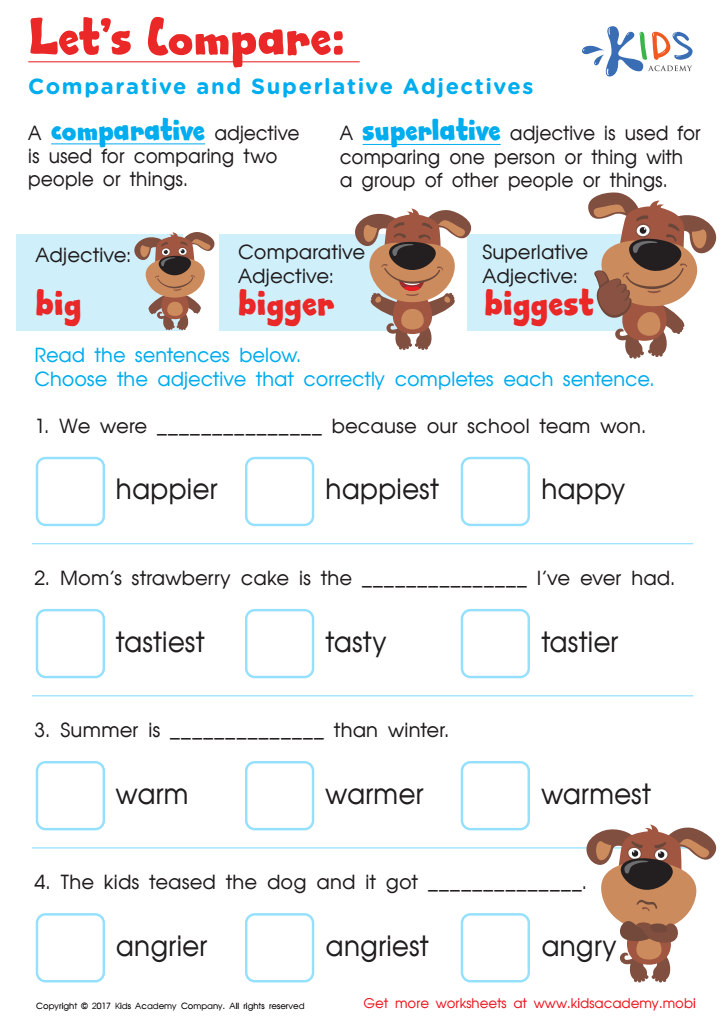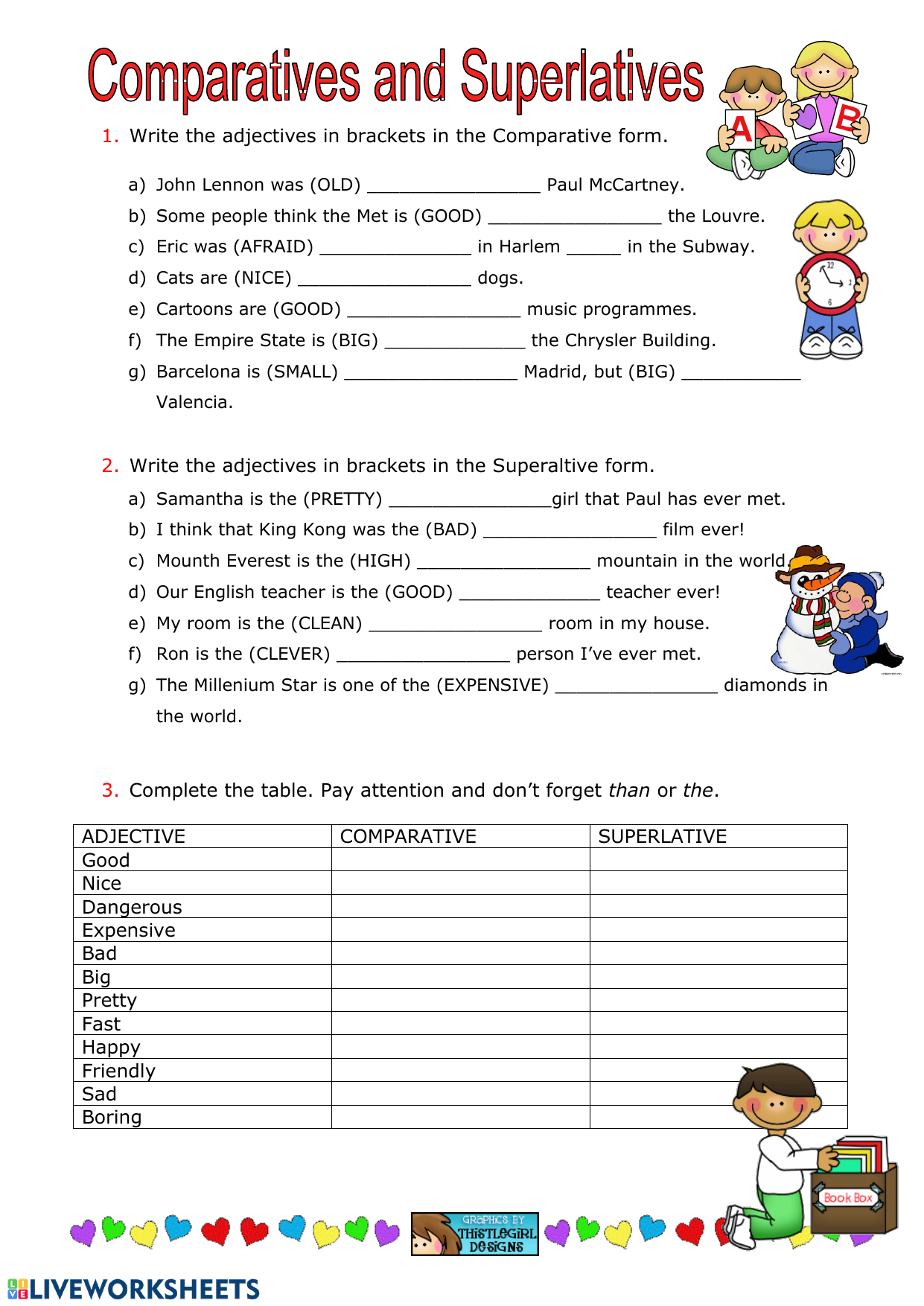
Mastering Degrees of Comparison: A Comprehensive Guide to Comparative and Superlative for Secondary Worksheets
The English language, with its rich tapestry of adjectives and adverbs, offers nuanced ways to describe and compare. Among the most fundamental yet often challenging aspects for language learners, particularly at the secondary level, are comparative and superlative forms. These grammatical structures allow us to express differences and extremes, essential for vivid descriptions, precise arguments, and effective communication. Crafting effective comparative and superlative for secondary worksheets is crucial for solidifying students’ understanding and application of these concepts.
This article delves into the intricacies of teaching comparatives and superlatives to secondary students, exploring common pitfalls, effective pedagogical strategies, and a wide array of activities that can be incorporated into engaging and impactful comparative and superlative for secondary worksheets. We aim to provide educators with a comprehensive resource to empower their students in mastering these vital grammatical tools.
Understanding the Fundamentals: A Quick Review

Before diving into worksheet design, it’s essential to revisit the core rules of forming comparatives and superlatives. Secondary students may have encountered these concepts before, but a quick review ensures a strong foundation.

-

One-Syllable Adjectives/Adverbs:

- Comparative: Add "-er" (e.g., tall -> taller, fast -> faster)
- Superlative: Add "-est" (e.g., tall -> tallest, fast -> fastest)
- Note: If the word ends in a single vowel + consonant, double the consonant before adding -er/-est (e.g., big -> bigger -> biggest). If it ends in -e, just add -r/-st (e.g., large -> larger -> largest).

-

Two-Syllable Adjectives/Adverbs:
- Ending in -y: Change -y to -i and add "-er" for comparative, "-est" for superlative (e.g., happy -> happier -> happiest, easy -> easier -> easiest).
- Others: Often use "more" for comparative and "most" for superlative (e.g., boring -> more boring -> most boring, careful -> more careful -> most careful). Note: Some two-syllable words can use either (e.g., cleverer/more clever, simplest/most simple). This can be a point of confusion.


-
Three or More Syllable Adjectives/Adverbs:
- Comparative: Use "more" (e.g., beautiful -> more beautiful, difficult -> more difficult)
- Superlative: Use "most" (e.g., beautiful -> most beautiful, difficult -> most difficult)
-
Irregular Forms: These must be memorized.
- good/well -> better -> best
- bad/badly -> worse -> worst
- far -> farther/further -> farthest/furthest
- little -> less -> least
- much/many -> more -> most

Why Secondary Students Often Struggle
While the rules seem straightforward, secondary students frequently encounter specific difficulties:
- Over-generalization: Applying "-er/-est" to all adjectives, regardless of syllable count, or conversely, using "more/most" for single-syllable words.
- Confusion with "than" and "the": Forgetting to include "than" in comparative sentences or "the" before the superlative form.
- Irregular forms: These are pure memorization and often get mixed up.
- Contextual nuance: Understanding when to use a comparative versus a superlative, or when to use further vs. farther.
- Adjective vs. Adverb: Differentiating between modifying nouns (adjectives) and verbs/adjectives/other adverbs (adverbs) when forming comparatives/superlatives (e.g., She sings better vs. She is a better singer).
- Spelling Rules: Incorrectly applying the doubling consonant rule or the -y to -i change.
Addressing these common pitfalls systematically through targeted exercises is key to designing effective comparative and superlative for secondary worksheets.
Principles for Designing Effective Worksheets
Effective comparative and superlative for secondary worksheets go beyond simple fill-in-the-blanks. They should be:
- Varied in Activity Type: Incorporate a range of tasks to cater to different learning styles and maintain engagement.
- Contextualized: Present grammar in meaningful sentences, paragraphs, or scenarios, rather than isolated words. This helps students understand the purpose of the grammar.
- Scaffolded: Start with simpler tasks (recognition, basic formation) and gradually move to more complex ones (sentence creation, error correction, paragraph writing).
- Relevant and Engaging: Use topics that resonate with secondary students’ interests, such as technology, sports, travel, social issues, or personal preferences.
- Clear and Concise: Instructions should be easy to understand, and examples should be provided for each new activity type.
- Focus on Application: Encourage students to produce their own sentences and paragraphs using the target grammar.
Engaging Comparative and Superlative for Secondary Worksheets: Activity Ideas
Here are specific ideas for activities to include in your worksheets, moving from basic reinforcement to more complex application:
Section 1: Foundations and Reinforcement
-
Rule Recalculation & Categorization:
- Provide a list of adjectives/adverbs and ask students to categorize them by the rule (e.g., "add -er/-est," "use more/most," "irregular," "change -y to -i").
- Example:
- Word List: big, happy, beautiful, good, bad, interesting, fast, dangerous, easy, far
- Task: Sort the words into the correct formation categories for comparative and superlative forms.
-
Fill-in-the-Blanks (Basic Formation):
- Present sentences with blanks where students need to insert the correct comparative or superlative form of a given adjective/adverb.
- Example:
- This book is ___ (interesting) than the last one.
- Mount Everest is the ___ (high) mountain in the world.
- She sings ___ (good) now than she did last year.
-
Sentence Transformation:
- Give a basic sentence and ask students to rewrite it using a comparative or superlative.
- Example:
- Original: My brother is tall. (Use comparative)
- Transformed: My brother is taller than me.
- Original: This is a very exciting movie. (Use superlative)
- Transformed: This is the most exciting movie I’ve ever seen.
Section 2: Contextual Application (Comparatives)
-
Compare and Contrast (Paragraph Level):
- Provide two short texts or descriptions of two similar items (e.g., two cities, two types of phones, two historical figures, two different sports).
- Task: Ask students to write a paragraph comparing them using at least 5-7 comparative adjectives/adverbs.
- Example: "Compare living in a big city to living in a small town. Think about noise, opportunities, pace of life, and community."
-
Picture Comparison:
- Show two pictures (e.g., two different cars, two rooms, two people).
- Task: Students write sentences comparing elements in the pictures using comparative forms.
- Example: "Picture A shows a car that is older than the car in Picture B. The room in Picture A looks cozier than the room in Picture B."
-
Debate Prompts:
- Provide a statement and ask students to write arguments for one side using comparative language.
- Example: "Online learning is better than traditional classroom learning." Students write 3-5 sentences arguing for online learning, using comparatives. ("It is more flexible…", "Students can learn at a faster pace…", "It is often cheaper…")
-
"Would You Rather?" Scenarios:
- Present "Would you rather…?" questions that naturally elicit comparative answers.
- Example: "Would you rather have a pet dog or a pet cat? Explain your choice using comparatives." ("A dog is more loyal than a cat…", "Cats are quieter than dogs…")
Section 3: Contextual Application (Superlatives)
-
"Top 5" Lists:
- Students create their own "Top 5" lists on various topics and justify their choices using superlatives.
- Example Topics: "The Top 5 Most Interesting Books," "The Top 5 Funniest Movies," "The Top 5 Most Important Inventions," "The Top 5 Most Beautiful Places on Earth."
-
Describing a "Best/Worst" Experience:
- Task: Students write a short paragraph describing the best vacation they ever had, the worst meal they ever ate, or the most challenging subject they’ve studied. Encourage the use of multiple superlative forms.
-
Fact or Opinion Challenge:
- Provide a list of statements, some factual (using superlatives correctly) and some opinion-based or grammatically incorrect.
- Task: Students identify if the statement is a fact or opinion and correct any grammatical errors.
- Example: "The Pacific Ocean is the deepest ocean in the world." (Fact) "My school is the most best school." (Incorrect grammar, Opinion)
-
"Who Am I?" or "What Am I?" Riddles:
- Students write riddles using superlative descriptions, and classmates guess the answer.
- Example: "I am the largest animal on Earth. I am the heaviest mammal. What am I?" (A blue whale)
Section 4: Integrated Skills and Advanced Concepts
-
Error Correction Paragraphs:
- Present a paragraph containing several errors in comparative and superlative usage.
- Task: Students identify and correct the errors. This requires close reading and application of rules.
-
Dialogue Creation:
- Students write a short dialogue between two or more people discussing preferences or comparing things, naturally incorporating comparatives and superlatives.
- Example Scenario: Two friends planning a trip, two classmates discussing their favorite sports teams, or a family deciding on a new car.
-
Adjective/Adverb Differentiation:
- Include exercises where students choose between the adjective or adverb form before applying the comparative/superlative rule.
- Example: "She speaks very (good/well). She speaks (gooder/better) than her brother."
-
Sentence Combining:
- Give two simple sentences and ask students to combine them into one sentence using a comparative or superlative.
- Example: "The cheetah runs fast. The gazelle runs fast too." -> "The cheetah runs faster than the gazelle."
The true value of robust comparative and superlative for secondary worksheets lies not just in testing knowledge but in fostering a deeper understanding and practical application of these grammatical structures. By offering varied, engaging, and contextualized activities, educators can help students move beyond rote memorization to confident and accurate usage.
Beyond the Worksheet: Reinforcement Strategies
While worksheets are invaluable, supplementing them with other activities enhances learning:
- Games: "Guess Who" (using comparatives like "Is your person taller than mine?"), "20 Questions" (using superlatives like "Is it the largest animal?"), or grammar board games.
- Class Discussions: Encourage students to use comparatives and superlatives naturally when discussing opinions, preferences, or analyzing texts.
- Project-Based Learning: Assign projects where students need to research and compare data (e.g., comparing different countries’ economies, historical periods, or scientific theories) and present their findings using comparative and superlative language.
- Peer Correction: Encourage students to review each other’s work, identifying and correcting errors, which reinforces their own understanding.
- Technology Integration: Utilize online quizzes, interactive grammar exercises, or digital tools for collaborative writing tasks that require the use of comparatives and superlatives.
Assessment and Differentiation
Assessing student mastery of comparatives and superlatives should be multifaceted. Beyond traditional worksheet grading, consider:
- Observation: Note how students use these forms in spoken discussions or informal writing.
- Creative Writing: Evaluate their ability to integrate comparatives and superlatives naturally into stories, essays, or descriptions.
- Presentations: Assess their use of comparative and superlative language when presenting information or arguments.
For differentiation, provide:
- Support for Struggling Learners: Simpler sentences, fewer options in multiple-choice questions, or direct instruction on specific rules they find challenging. Provide sentence frames or word banks.
- Challenge for Advanced Learners: More complex sentences, opportunities for nuanced comparisons (e.g., using "less/least," "as…as"), or tasks that require critical thinking and extended writing. Encourage them to analyze literary texts for effective use of comparatives and superlatives.
Conclusion
Mastering comparative and superlative forms is a cornerstone of effective communication in English. For secondary students, this involves not just memorizing rules but understanding their application in diverse contexts. By designing thoughtfully structured, varied, and engaging comparative and superlative for secondary worksheets, educators can transform a potentially dry grammar topic into an exciting journey of discovery. Coupled with dynamic classroom activities and targeted feedback, these worksheets will undoubtedly empower students to express themselves with greater precision, clarity, and descriptive power, laying a strong foundation for their continued linguistic development. Through consistent practice and creative application, students will confidently navigate the degrees of comparison, becoming more articulate and sophisticated users of the English language.
